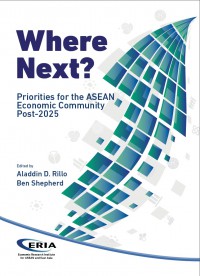Monitoring the ASEAN Economic Community: Towards a New Approach

Chapter 19: It has been observed on a number of occasions that the development effectiveness and impact of regional economic cooperation or integration policies crucially depends on the implementation and uptake of regionally agreed policies, and that monitoring, including indicator-based monitoring, can be an important part of the policy puzzle (Schiff and Winters, 2003; World Bank, 2005; De Lombaerde, Estevadeordal, and Suominen, 2008; De Lombaerde, Saucedo Acosta, and Vida, 2017).
In the case of the Association of Southeast Asian Nations (ASEAN), monitoring systems to accompany the regional integration process include the ASEAN Community Progress Monitoring System initiated in 2000, and the ASEAN Economic Community (AEC) Scorecard, developed in 2008 in response to the signing of the AEC Blueprint in 2007.
The creation of the AEC, with a 2020 target date, was proposed at the Heads of Government Meeting/the 8th ASEAN Summit in Phnom Penh in November 2002. The AEC was agreed in principle at the October 2003 ASEAN Summit in Bali (Plummer, 2006). The AEC is essentially conceived as a common market, taking into account the specific institutional context of ASEAN. Its legal situation has been considered as complex because of the absence of a treaty base, a hard definition of the common market, and a court (Pelkmans, 2024). The AEC consists in practice of a set of building blocks of a common market, some of which were already operating before the announcement of the AEC.
Trade liberalisation was initiated in 1992 with the ASEAN Free Trade Area, characterised by gradual tariff reductions or eliminations through the Common Effective Preferential Tariff scheme. The ASEAN Trade in Goods Agreement (ATIGA) was signed in 2009 and entered into force in 2010. In addition to expanding the scope of the Common Effective Preferential Tariff, the ATIGA included provisions on the codification and reduction of non-tariff measures, rules of origin, trade facilitation, and sanitary and phytosanitary measures. A new institution was also created: the Coordinating Committee for the Implementation of the ATIGA.
Trade in services was first dealt with through the ASEAN Framework Agreement on Services (AFAS), in force since 1998. The AFAS has made gradual progress through a sequence of packaged liberalisation commitments, especially since the AEC Blueprint (2008–2015). The ASEAN Trade in Services Agreement was signed in 2020 as the new legal instrument for the integration of the services market. With the ASEAN Trade in Services Agreement, the commitment schedules under the AFAS, which are based on a positive list approach, will be transformed into schedules of non-conforming measures, based on a negative list approach in combination with time frames. For air transport, telecommunications, and financial services, separate routes are explored. For air transport services, the ASEAN Single Aviation Market was proposed in 2007, and open skies protocols have followed.
Liberalisation and regulation of financial services and capital movements are guided by the 2018 CSAP but are generally less ambitious in terms of market integration. The outlier here is intra-ASEAN foreign direct investment, which has been liberalised with few exceptions. Foreign direct investment policies are guided by the ASEAN Comprehensive Investment Agreement, which took effect in 2012, consolidating and building on two pre-existing agreements: the Framework Agreement on the ASEAN Investment Area and the ASEAN Investment Guarantee Agreement. Meanwhile, for the movement of skilled labour, the provisions are guided by Mutual Recognition Agreements (MRAs), which allow for the skills, accreditations, and experience of skilled workers to be recognised outside their home country. Current MRAs encompass six sectors: engineering, nursing, architecture, medicine, dentistry, and tourism. Two framework agreements are in place – surveying qualifications and accountancy services (ASEAN, n.d.).
This chapter is organised as follows: in section 2, the current AEC monitoring framework is assessed. Section 3 presents international mapping and benchmarking of indicator-based monitoring experiences worldwide, with a focus on their aims and scope. Building on the two preceding sections, section 4 presents guidance on how to adapt the AEC monitoring system for the future.
Full text of Chapter 19 can be found here: Where Next? Priorities for the ASEAN Economic Community Post 2025
